Igor Spasojevic
Gaussian Splatting as a Unified Representation for Autonomy in Unstructured Environments
May 17, 2025Abstract:In this work, we argue that Gaussian splatting is a suitable unified representation for autonomous robot navigation in large-scale unstructured outdoor environments. Such environments require representations that can capture complex structures while remaining computationally tractable for real-time navigation. We demonstrate that the dense geometric and photometric information provided by a Gaussian splatting representation is useful for navigation in unstructured environments. Additionally, semantic information can be embedded in the Gaussian map to enable large-scale task-driven navigation. From the lessons learned through our experiments, we highlight several challenges and opportunities arising from the use of such a representation for robot autonomy.
ATLAS Navigator: Active Task-driven LAnguage-embedded Gaussian Splatting
Feb 27, 2025Abstract:We address the challenge of task-oriented navigation in unstructured and unknown environments, where robots must incrementally build and reason on rich, metric-semantic maps in real time. Since tasks may require clarification or re-specification, it is necessary for the information in the map to be rich enough to enable generalization across a wide range of tasks. To effectively execute tasks specified in natural language, we propose a hierarchical representation built on language-embedded Gaussian splatting that enables both sparse semantic planning that lends itself to online operation and dense geometric representation for collision-free navigation. We validate the effectiveness of our method through real-world robot experiments conducted in both cluttered indoor and kilometer-scale outdoor environments, with a competitive ratio of about 60% against privileged baselines. Experiment videos and more details can be found on our project page: https://atlasnav.github.io
RT-GuIDE: Real-Time Gaussian splatting for Information-Driven Exploration
Sep 26, 2024Abstract:We propose a framework for active mapping and exploration that leverages Gaussian splatting for constructing information-rich maps. Further, we develop a parallelized motion planning algorithm that can exploit the Gaussian map for real-time navigation. The Gaussian map constructed onboard the robot is optimized for both photometric and geometric quality while enabling real-time situational awareness for autonomy. We show through simulation experiments that our method is competitive with approaches that use alternate information gain metrics, while being orders of magnitude faster to compute. In real-world experiments, our algorithm achieves better map quality (10% higher Peak Signal-to-Noise Ratio (PSNR) and 30% higher geometric reconstruction accuracy) than Gaussian maps constructed by traditional exploration baselines. Experiment videos and more details can be found on our project page: https://tyuezhan.github.io/RT_GuIDE/
Collision-free time-optimal path parameterization for multi-robot teams
Sep 25, 2024



Abstract:Coordinating the motion of multiple robots in cluttered environments remains a computationally challenging task. We study the problem of minimizing the execution time of a set of geometric paths by a team of robots with state-dependent actuation constraints. We propose a Time-Optimal Path Parameterization (TOPP) algorithm for multiple car-like agents, where the modulation of the timing of every robot along its assigned path is employed to ensure collision avoidance and dynamic feasibility. This is achieved through the use of a priority queue to determine the order of trajectory execution for each robot while taking into account all possible collisions with higher priority robots in a spatiotemporal graph. We show a 10-20% reduction in makespan against existing state-of-the-art methods and validate our approach through simulations and hardware experiments.
SlideSLAM: Sparse, Lightweight, Decentralized Metric-Semantic SLAM for Multi-Robot Navigation
Jun 25, 2024



Abstract:This paper develops a real-time decentralized metric-semantic Simultaneous Localization and Mapping (SLAM) approach that leverages a sparse and lightweight object-based representation to enable a heterogeneous robot team to autonomously explore 3D environments featuring indoor, urban, and forested areas without relying on GPS. We use a hierarchical metric-semantic representation of the environment, including high-level sparse semantic maps of object models and low-level voxel maps. We leverage the informativeness and viewpoint invariance of the high-level semantic map to obtain an effective semantics-driven place-recognition algorithm for inter-robot loop closure detection across aerial and ground robots with different sensing modalities. A communication module is designed to track each robot's observations and those of other robots within the communication range. Such observations are then used to construct a merged map. Our framework enables real-time decentralized operations onboard robots, allowing them to opportunistically leverage communication. We integrate and deploy our proposed framework on three types of aerial and ground robots. Extensive experimental results show an average localization error of 0.22 meters in position and -0.16 degrees in orientation, an object mapping F1 score of 0.92, and a communication packet size of merely 2-3 megabytes per kilometer trajectory with 1,000 landmarks. The project website can be found at https://xurobotics.github.io/slideslam/.
Optimal Convex Cover as Collision-free Space Approximation for Trajectory Generation
Jun 13, 2024Abstract:We propose an online iterative algorithm to find a suitable convex cover to under-approximate the free space for autonomous navigation to delineate Safe Flight Corridors (SFC). The convex cover consists of a set of polytopes such that the union of the polytopes represents obstacle-free space, allowing us to find trajectories for robots that lie within the convex cover. In order to find the SFC that facilitates optimal trajectory generation, we iteratively find overlapping polytopes of maximum volumes that include specified waypoints initialized by a geometric or kinematic planner. Constraints at waypoints appear in two alternating stages of a joint optimization problem, which is solved by a method inspired by the Alternating Direction Method of Multipliers (ADMM) with partially distributed variables. We validate the effectiveness of our proposed algorithm using a range of parameterized environments and show its applications for two-stage motion planning.
An Active Perception Game for Robust Autonomous Exploration
Mar 31, 2024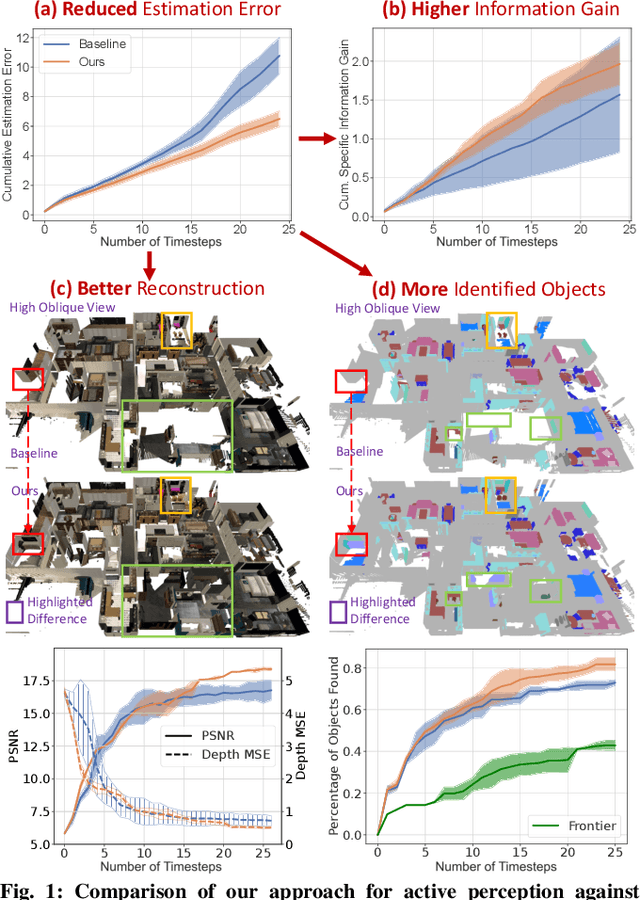
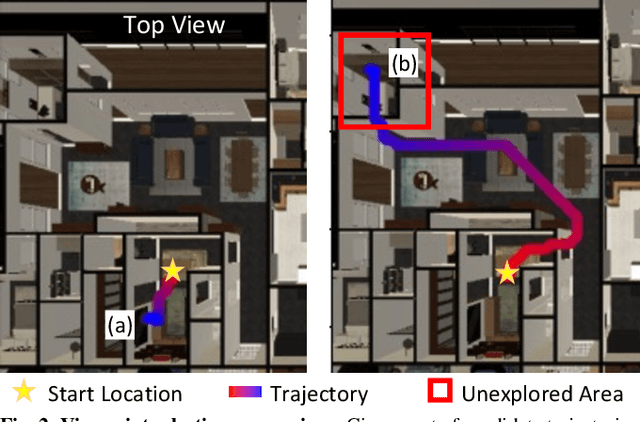
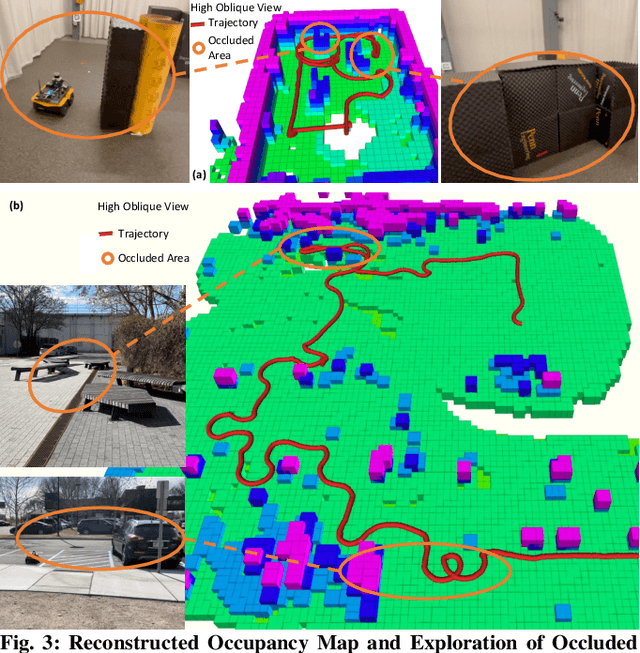

Abstract:We formulate active perception for an autonomous agent that explores an unknown environment as a two-player zero-sum game: the agent aims to maximize information gained from the environment while the environment aims to minimize the information gained by the agent. In each episode, the environment reveals a set of actions with their potentially erroneous information gain. In order to select the best action, the robot needs to recover the true information gain from the erroneous one. The robot does so by minimizing the discrepancy between its estimate of information gain and the true information gain it observes after taking the action. We propose an online convex optimization algorithm that achieves sub-linear expected regret $O(T^{3/4})$ for estimating the information gain. We also provide a bound on the regret of active perception performed by any (near-)optimal prediction and trajectory selection algorithms. We evaluate this approach using semantic neural radiance fields (NeRFs) in simulated realistic 3D environments to show that the robot can discover up to 12% more objects using the improved estimate of the information gain. On the M3ED dataset, the proposed algorithm reduced the error of information gain prediction in occupancy map by over 67%. In real-world experiments using occupancy maps on a Jackal ground robot, we show that this approach can calculate complicated trajectories that efficiently explore all occluded regions.
Trajectory Optimization with Global Yaw Parameterization for Field-of-View Constrained Autonomous Flight
Mar 25, 2024Abstract:Trajectory generation for quadrotors with limited field-of-view sensors has numerous applications such as aerial exploration, coverage, inspection, videography, and target tracking. Most previous works simplify the task of optimizing yaw trajectories by either aligning the heading of the robot with its velocity, or potentially restricting the feasible space of candidate trajectories by using a limited yaw domain to circumvent angular singularities. In this paper, we propose a novel \textit{global} yaw parameterization method for trajectory optimization that allows a 360-degree yaw variation as demanded by the underlying algorithm. This approach effectively bypasses inherent singularities by including supplementary quadratic constraints and transforming the final decision variables into the desired state representation. This method significantly reduces the needed control effort, and improves optimization feasibility. Furthermore, we apply the method to several examples of different applications that require jointly optimizing over both the yaw and position trajectories. Ultimately, we present a comprehensive numerical analysis and evaluation of our proposed method in both simulation and real-world experiments.
Learning Optimal Trajectories for Quadrotors
Sep 26, 2023



Abstract:This paper presents a novel learning-based trajectory planning framework for quadrotors that combines model-based optimization techniques with deep learning. Specifically, we formulate the trajectory optimization problem as a quadratic programming (QP) problem with dynamic and collision-free constraints using piecewise trajectory segments through safe flight corridors [1]. We train neural networks to directly learn the time allocation for each segment to generate optimal smooth and fast trajectories. Furthermore, the constrained optimization problem is applied as a separate implicit layer for back-propagating in the network, for which the differential loss function can be obtained. We introduce an additional penalty function to penalize time allocations which result in solutions that violate the constraints to accelerate the training process and increase the success rate of the original optimization problem. To this end, we enable a flexible number of sequences of piece-wise trajectories by adding an extra end-of-sentence token during training. We illustrate the performance of the proposed method via extensive simulation and experimentation and show that it works in real time in diverse, cluttered environments.
Navigation with shadow prices to optimize multi-commodity flow rates
Sep 25, 2023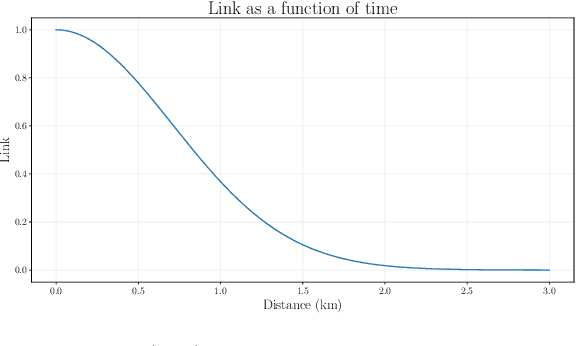
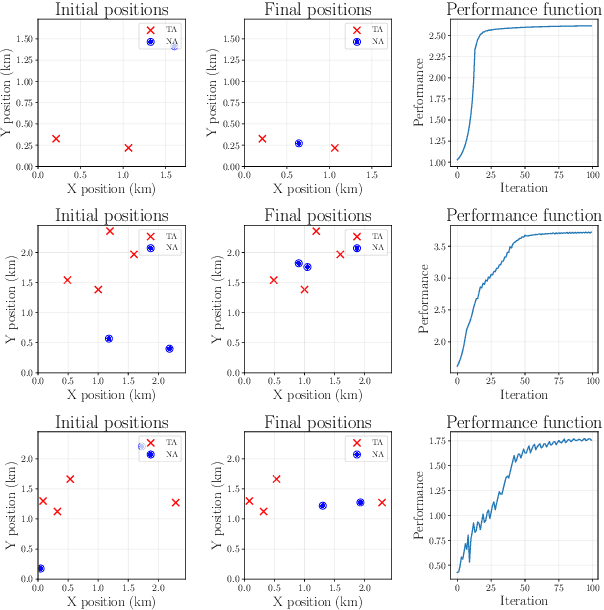
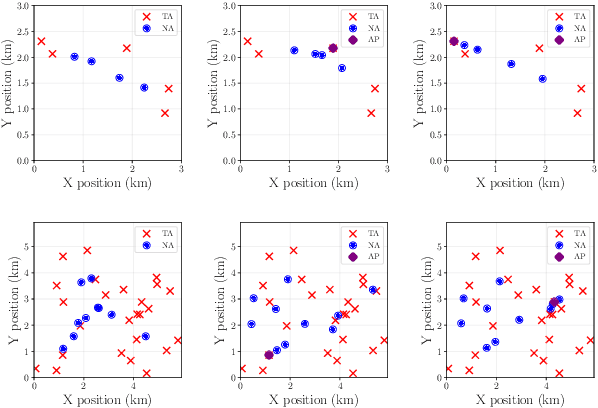
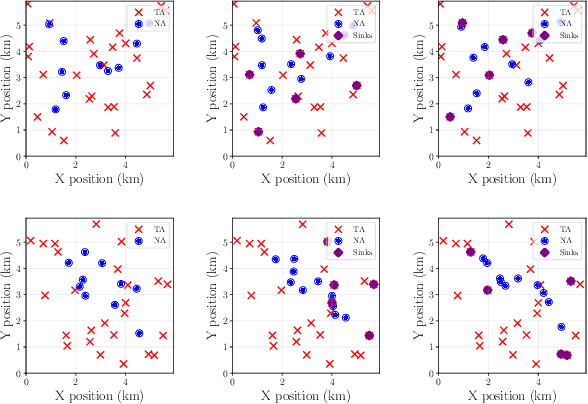
Abstract:We propose a method for providing communication network infrastructure in autonomous multi-agent teams. In particular, we consider a set of communication agents that are placed alongside regular agents from the system in order to improve the rate of information transfer between the latter. In order to find the optimal positions to place such agents, we define a flexible performance function that adapts to network requirements for different systems. We provide an algorithm based on shadow prices of a related convex optimization problem in order to drive the configuration of the complete system towards a local maximum. We apply our method to three different performance functions associated with three practical scenarios in which we show both the performance of the algorithm and the flexibility it allows for optimizing different network requirements.
 Add to Chrome
Add to Chrome Add to Firefox
Add to Firefox Add to Edge
Add to Edge